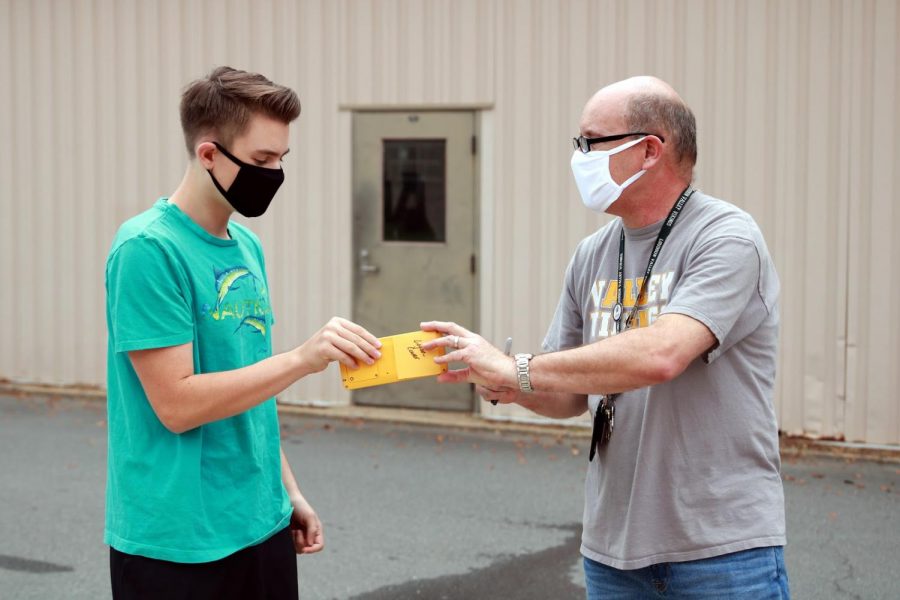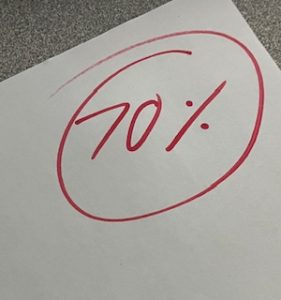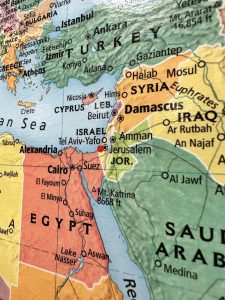How Teachers Are Adjusting to Distance Learning
A students receives a graphing calculator from math teacher Jose Rodriguez.
December 20, 2020
Chemistry teacher Jessie Sheehan chose to teach at home, but occasionally he goes to school and films in his lab.
“I mostly teach from home but will sometimes come into the lab to film chemistry demonstrations,” chemistry teacher Jesse Sheehan said. “I’m very fortunate to have a nice space where I can concentrate.”
Teaching from home and school is something that a majority of teachers at Valley have the advantage of choosing.
“I feel the importance of clarity with directions and instruction in this environment has made many of us better teachers,” Sheehan said. “I think routine is important and I try to maintain that, but add some variety within that routine to spice it up.”
Spanish teacher Elizabeth Stickley started out teaching at Valley but since Stickley was secluded from everyone, it made her realize that she might as well go home and teach from there.
“I started out by teaching at school but was pretty much isolated from everything except for my classroom,” Stickley said. “I had little interaction aside from lunch. I figured if I’m going to be stuck in my classroom, I might as well be at home. So now I primarily teach from home. I go into school when there is something that I need or I want to reach out to the other foreign language teachers that do go in daily.”
There are also teachers who decided to teach in the school building. German teacher Teresa Breitenthaler is among them.
“I prefer to teach in the building, as it puts me more in the mindset of school and work,” Breitenthaler said via email. “I would find too many distractions if I were home (laundry, cooking).”
One challenge teachers have faced is getting to know their students. Sheehan has adjusted to this problem with a little help.
¨I think this aspect turned out to be better than I expected,” Sheehan said. “I think the answer is in short, open-ended assignments, rotating through breakout groups, and taking time to just talk about stuff. Of course, feeling like you know students and actually knowing your students are two different things, so I keep trying to make as few assumptions as possible.”
Sheehan uses different activities so everyone can interact and actually get to know each other.
¨I am finding it easier to get to know my students than I thought it would be. I ask the kids to keep cameras on so I can judge their level of understanding,” he said. “I feel that those who participate, I can get to know. Those who refuse to turn cameras on or to participate, well, I don’t know them at all.¨
Since this is the first year that teachers have had to teach online, they’ve all come across hurdles. Stickley notes that problems exist, and that obstacles have had to be overcome.
“First, nothing is easy,” Stickley said. “The technology doesn’t work the way it should all of the time, the internet can come and go during class, new technology (Schoology) carries with it a learning curve, there is a new grading policy, and having to figure out how to recreate materials for online learning is time consuming. There is the added challenge of getting kids to speak the target language.”
Chemistry teacher Chad Dawson said lack of participation has an impact, too.
¨Virtual teaching and learning are difficult,” Dawson said. “All successful endeavors that I have been fortunate to be a part of involve positive relationship-building, and that is very difficult online.”







